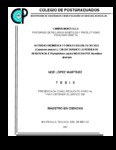Actividad enzimática y fenoles solubles en chile (Capsicum annum L.) CM-334 durante la pérdida de resistencia a Phytophthora capsici inducida por Nacobbus aberrans
Abstract
El genotipo de chile CM-334 es resistente al oomiceto Phytopthora capsici (Pc), pero N. aberrans (Na) si esta presente inhibe su resistencia. Conocer los cambios metabólicos inducidos por Na, puede ayudar a entender el fenómeno de pérdida o inhibición de la resistencia. Así, se comparó la actividad enzimática de peroxidasas, fenilalanina amonio liasa (PAL), el contenido de fenoles solubles totales (FST) en plantas CM-334 inoculadas con cada patógeno y con la combinación de ambos; así como el contenido de ácido clorogénico en plantas de chile resistente (CM-334) y susceptible (J.E. Parker) al oomiceto inoculadas solamente con Na. En los muestreos realizados durante las 96 h posteriores a la inoculación con el oomiceto, generalmente en las plantas inoculadas con el oomiceto, la mayor actividad de peroxidasas, PAL y FST se registró en las plantas inoculadas únicamente con Pc; en cambio la mínima actividad correspondió a plantas inoculadas sólo con Na (P < 0.05). Las plantas inoculadas con ambos patógenos (Na-Pc) y las del testigo sin inocular (PSI) tuvieron un comportamiento similar (P < 0.05). Por otro lado, el contenido de ácido clorogénico en las plantas tanto de CM-334 como de J.E. Parker inoculadas con Na, fue significativamente menor que el de las plantas de ambos materiales de chile sin inocular. Los resultados obtenidos sugieren que la infección por Na reduce las respuestas de defensa a P. c en plantas de chile CM-334 y que por lo tanto la pérdida o inhibición de la resistencia a P. capsici inducida por N. aberrans puede en parte asociarse con una reducción en la actividad enzimática de las peroxidasas, la PAL, el contenido de fenoles solubles totales y de ácido clorogénico.________The genotype CM-334 of Chili (Capsicum annuun) is resistant to Phytopthora capsici (Pc), but Nacobbus aberrans (Na) if is present breaks down its resistance. To know the metabolic changes induced by Na can help to understand the phenomenon of break down to resistance. Therefore, it was compared peroxidase and L-phenylalanine ammonia-lyase (PAL) activities and total soluble phenols (TSP) in chilli plants CM-334 inoculated with N. aberrans, alone or in combination with P. capsici, and chlorogenic acid concentration in resistant (CM-334) and susceptible (J.E. Parker) plants to Pc inoculated only with Na. At different evaluation times during 96 h after the inoculation with the oomycete, generally the highest POD and PAL activities, and the content TSP were registered in plants inoculated only with Pc, while the minimal activity corresponded to plants inoculated only with Na (P < 0.05). The non-inoculated plants and those with both pathogens had similar, intermediate behavior. Chlorogenic acid concentrations in CM-334 and J.E. Parker plants inoculated with Na were significantly lower than in non-inoculated. These results suggest that the infection by N. aberrans decreased defence to P. capsici in CM-334 chilli plants and therefore, resistance break down to P. capsici induced by Na can be associated with a reduction in peroxidase and PAL activities, the TSP and chlorogenic acid concentration.
Collections
- Tesis MC, MT, MP y DC [131]


